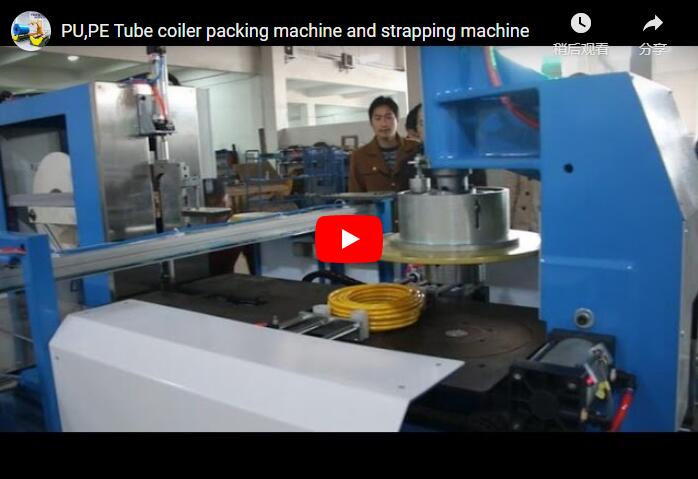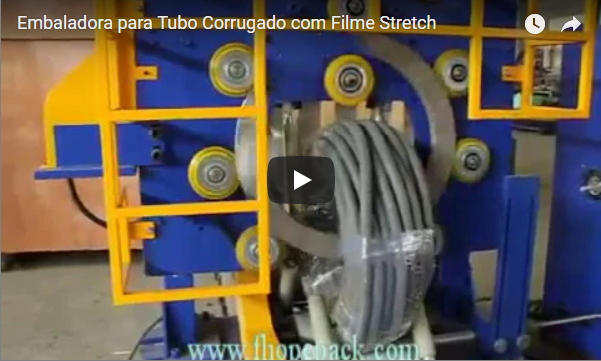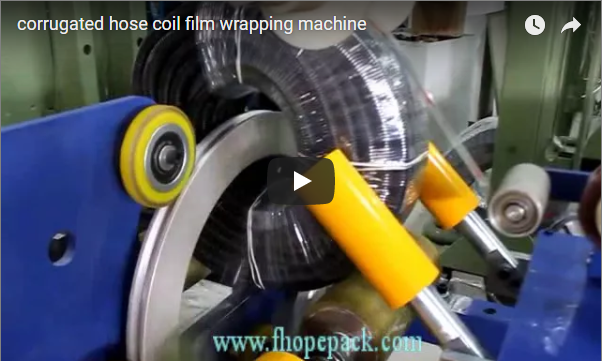Enhancing Packaging Efficiency: A Deep Dive into Small Coil Wrapping Machines for Cable and Wire
Introduction: Addressing Modern Packaging Challenges
In industries ranging from electrical cable manufacturing to automotive component supply, the efficient and secure packaging of small coiled products is paramount. Manual wrapping methods are often labor-intensive, inconsistent, and inadequate for protecting sensitive materials during transit and storage. Small coil wrapping machines represent a significant technological advancement, offering automated solutions that enhance productivity, improve package integrity, and reduce operational costs. This article explores the operational principles, engineering design considerations, technical specifications, and diverse applications of these essential industrial machines, drawing insights from established engineering practices and packaging science principles.
Operating Principle and Mechanism Design
At its core, a small coil wrapping machine automates the application of stretch film or other wrapping materials around a coiled product. The fundamental operation involves relative motion between the coil and the film dispensing system. Common designs include:
- Rotating Ring Machines: The coil remains stationary or indexes through the machine's aperture while a ring carrying the film dispenser rotates around it. This design is often favored for its speed and ability to tightly wrap various coil shapes. Patents like US Patent 6,874,302 B2 detail advancements in ring-type wrapper designs focusing on film tension control and cutting mechanisms.
- Turntable Machines: The coil is placed on a rotating turntable, and a stationary or vertically moving film mast dispenses the wrap. While conceptually simpler, this may be less suitable for coils requiring wrapping through the eye.
- Orbital Stretch Wrappers: Specialized designs where the film carriage orbits through the eye of the coil, ensuring complete encapsulation. This is particularly relevant for toroidal objects or coils where central protection is critical.
The process typically involves:
- Loading: Manual or automated placement of the coil onto the wrapping station.
- Film Application: The machine securely attaches the film lead to the coil.
- Wrapping Cycle: The relative rotation (ring or turntable) commences, dispensing the film. Advanced systems incorporate programmable logic controllers (PLCs) to manage wrap patterns (e.g., number of top/bottom wraps, overlap percentage).
- Tension Control: Crucial for both package security and material efficiency. Mechanisms often employ pre-stretch rollers, as highlighted in research published in journals like Packaging Technology and Science. Pre-stretching elongates the film before application (often up to 250-300%), increasing tensile strength and significantly reducing film consumption per coil.
- Film Cutting & Clamping: Automated systems cut the film tail and clamp or wipe it down securely against the coil, preparing the machine for the next cycle.
Key Design Features and Engineering Considerations
The performance and reliability of a small coil wrapping machine hinge on several engineering aspects aligned with principles often discussed in Machine Design:
- Structural Integrity: Robust frame construction using materials like heavy-gauge steel is necessary to withstand continuous operation and vibration, ensuring alignment of critical components like the rotating ring or turntable drive systems.
- Drive Systems: Variable Frequency Drives (VFDs) are commonly used for precise control over rotation speed and acceleration/deceleration, minimizing stress on the product and machine components.
- Film Carriage Design: The design must ensure smooth film dispensing and consistent pre-stretch levels. Features may include feedback sensors for film tension monitoring and automatic adjustment capabilities.
- Control System & Automation: PLCs (e.g., Siemens, Allen-Bradley) coupled with HMIs (Human-Machine Interfaces) allow for user-friendly operation, recipe storage for different coil types, diagnostic feedback, and potential integration with factory MES (Manufacturing Execution Systems) or ERP (Enterprise Resource Planning) systems via industrial communication protocols.
- Material Compatibility: Designed primarily for Linear Low-Density Polyethylene (LLDPE) stretch film, but adaptable for other materials like Polyvinyl Chloride (PVC), Polyethylene (PE), or even VCI (Vapor Corrosion Inhibitor) films for enhanced metal protection.
- Safety Features: Compliance with safety standards (e.g., ISO 13849-1) is critical. Features include emergency stop circuits, safety interlocks on access doors, light curtains guarding the wrapping zone, and overload protection for motors.
Technical Specifications Overview
While specific parameters vary based on model and manufacturer, typical specifications for a small coil wrapping machine include:
Disclaimer: The parameters below provide a general reference and may not precisely match the equipment shown in the video. For exact specifications tailored to your application, please contact the manufacturer.
- Machine Type: Automatic / Semi-Automatic
- Coil Handling:
- Outer Diameter (OD): Typically up to 800 mm (can vary significantly)
- Inner Diameter (ID): Minimum ID constraints apply, especially for orbital wrappers
- Width/Height: Defines the maximum coil dimension perpendicular to the wrapping axis
- Weight Capacity: Maximum allowable coil weight
- Wrapping Performance:
- Wrapping Material: LLDPE Stretch Film, PVC, PE, VCI Paper/Film
- Maximum Film Width: e.g., 100 mm - 500 mm
- Film Roll Core Diameter: Standard 76 mm (3 inches)
- Film Roll Outer Diameter: Max capacity, e.g., 250 mm
- Rotation Speed: Variable, e.g., up to 100 RPM (influences cycle time)
- Pre-stretch Ratio: Adjustable, potentially up to 300%
- Production Capacity: e.g., 30-60 coils per hour (dependent on coil size and wrap parameters)
- System Configuration:
- Control System: PLC with HMI Touchscreen
- Operation Mode: Manual setup/Automatic cycle
- Power Requirement: e.g., 220V/380V, 50/60Hz, 3-Phase (region-specific)
- Required Air Pressure: e.g., 5-6 bar (for pneumatic components)
- Physical Dimensions & Safety:
- Machine Footprint (LxWxH): Varies, designed for compactness
- Machine Weight: e.g., Approx. 400 kg
- Safety Features: E-stop, Interlocks, Overload Protection
- Noise Level: Typically designed to operate below 75 dB
Diverse Industrial Applications
The utility of small coil wrapping machines spans numerous sectors:
- Electrical Cable and Wire Manufacturing: Protects insulation from abrasion, moisture, and UV exposure. Ensures coils remain tightly wound and manageable for storage, distribution, and installation. Prevents tangling ("bird-nesting") which can impede automated payout systems.
- Automotive Component Production: Wraps coils of hoses (brake, fuel, hydraulic), wiring harnesses, and small metal tubes. Provides a clean, secure package essential for Just-In-Time (JIT) supply chains and protects sensitive components from contamination or damage during inter-plant logistics.
- Construction and Industrial Supplies: Secures coils of rope, wire rope, small-diameter PEX or copper tubing, and banding materials. Protects against harsh environmental conditions on job sites or in warehouses. Facilitates easier handling and inventory management.
- Metals Industry: Packaging smaller coils of steel wire, aluminum wire, or copper wire. VCI film can be used to prevent corrosion during long-term storage or overseas shipment.
- Textiles and Plastics: Wrapping coils of yarn, thread, ribbon, or plastic tubing. Maintains product cleanliness and prevents unwinding.
Conclusion: A Strategic Investment in Packaging Automation
Investing in a small coil wrapping machine offers tangible benefits beyond basic packaging. It enhances operational efficiency through increased throughput and reduced labor requirements compared to manual methods. Consistent wrap quality and optimized film usage (via pre-stretch) improve load containment, product protection, and reduce material costs. The resulting packages are professional, easily handled, and contribute to streamlined logistics and inventory processes. As industries continue to pursue automation for quality improvement and cost reduction, these machines represent a reliable and effective solution for small coil packaging challenges.
Our small coil wrapping machine is engineered for reliability and ease of use, providing a robust solution for your coil wrapping needs. It operates significantly faster and more consistently than manual wrapping, directly boosting productivity and potentially improving profitability. If you wish to explore detailed specifications, customization options, or request a quote for our small coil wrapping machine, please contact us today.
For information on a broader range of coil packing machine solutions, visit our partner site.






